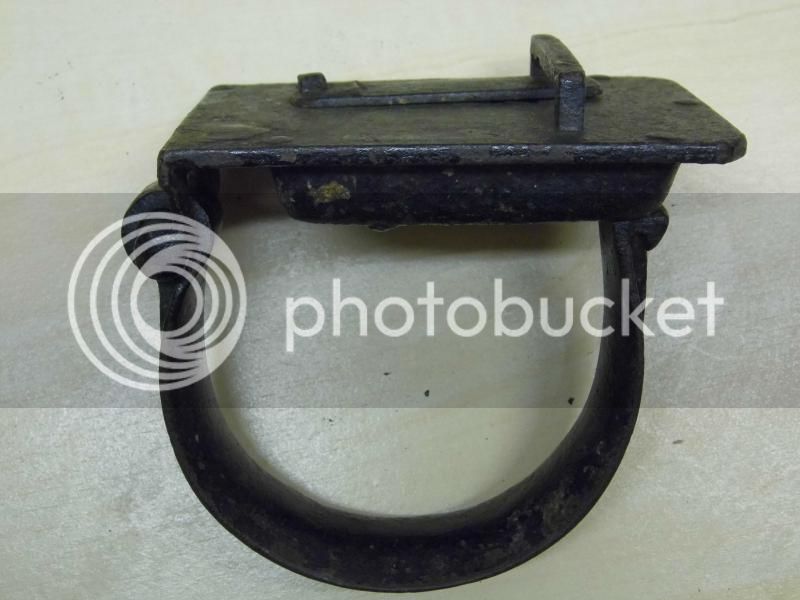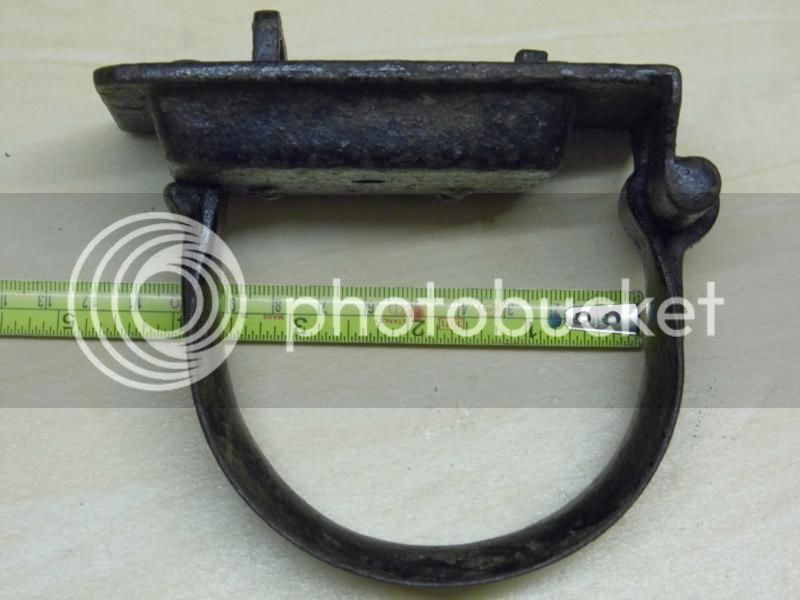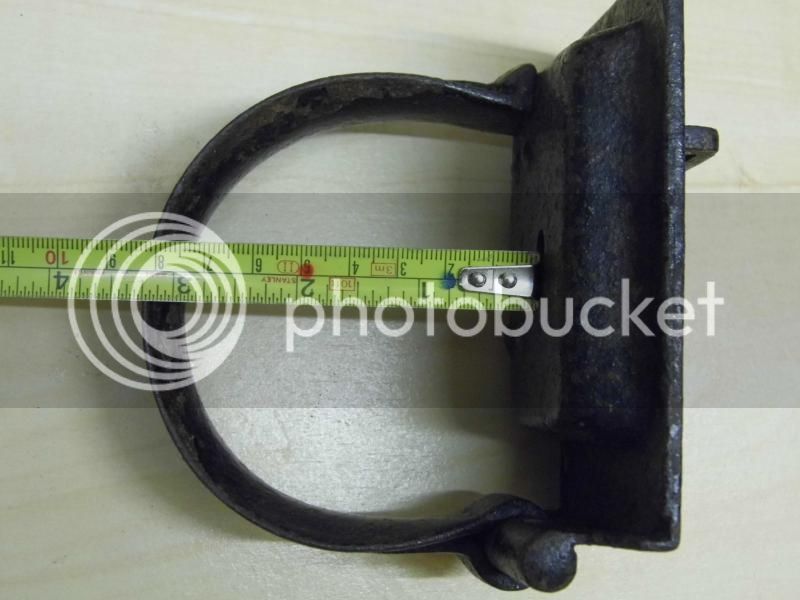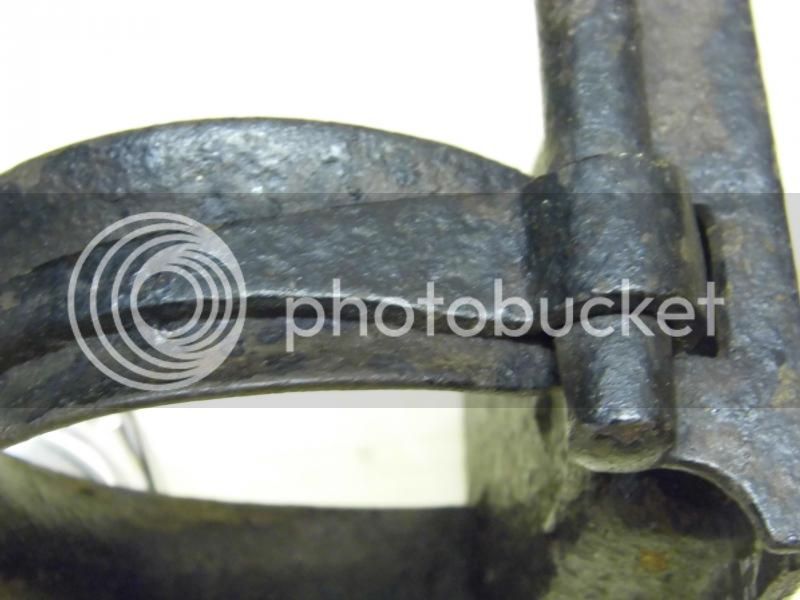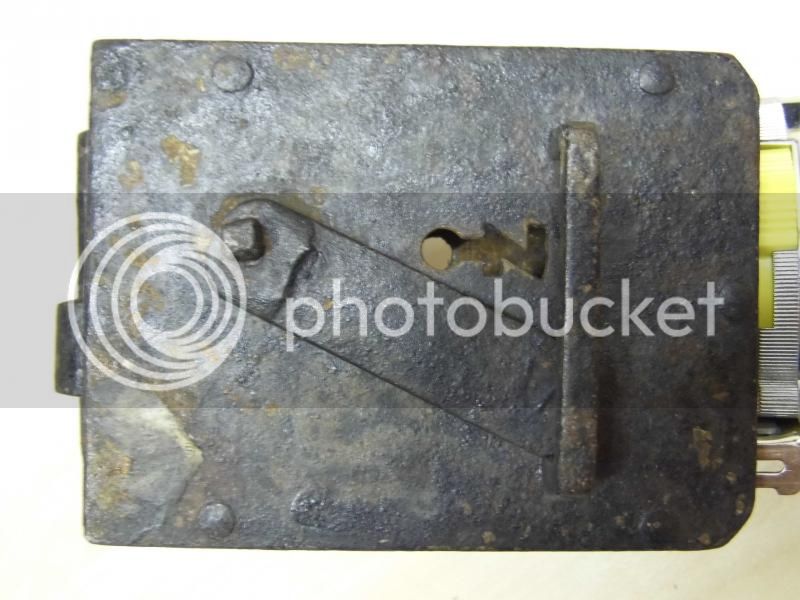You are using an out of date browser. It may not display this or other websites correctly.
You should upgrade or use an alternative browser.
You should upgrade or use an alternative browser.
Help with mystery z key locking gizmo identification.
- Thread starter toolsntat
- Start date

Help Support UKworkshop.co.uk:
This site may earn a commission from merchant affiliate
links, including eBay, Amazon, and others.
Random Orbital Bob
Established Member
Medieval "cock ring".....no question 
Random Orbital Bob
Established Member
12th Century handbag hook?
bugbear
Established Member
The cover for the keyhole is presumably intended to hang down
vertically, so the device is meant to be used in that orientation.
The hasp is rounded, to protect whatever's in there (fabric or flesh?)
Not much, I know, but it's all I've got...
BugBear
vertically, so the device is meant to be used in that orientation.
The hasp is rounded, to protect whatever's in there (fabric or flesh?)
Not much, I know, but it's all I've got...
BugBear
dc_ni
Established Member
You could try posting on here to see if anyone knows what it is.
http://www.antique-locks.com/forum.php?s=9ec70f58f7aead044f68e3a4ec568c9f
http://www.antique-locks.com/forum.php?s=9ec70f58f7aead044f68e3a4ec568c9f
bugbear
Established Member
dc_ni":psq3yokb said:You could try posting on here to see if anyone knows what it is.
http://www.antique-locks.com/forum.php?s=9ec70f58f7aead044f68e3a4ec568c9f
The internet really does have a forum for everything, doesn't it.
BugBear
finneyb
Established Member
Chastity belt lock ???
Brian
Brian
Sheffield Tony
Ghost of the disenchanted
Andy has shown me the real thing at MAC Timbers. Not that it helps much, but ...
Seeing the tape there, one thing occurs. I've made a few bangles, and 70mm is quite a large size. I could get it on and off over my hand. That wouldn't restrain a wrist unless the owner had HUGE hands. Unless the hasp passes through a slot in something ~30mm thick that takes up a fair bit of that space.
But if it were meant to restrain a leg, it would only make sense if the subject were horizontal, and outdoors ?
Seeing the tape there, one thing occurs. I've made a few bangles, and 70mm is quite a large size. I could get it on and off over my hand. That wouldn't restrain a wrist unless the owner had HUGE hands. Unless the hasp passes through a slot in something ~30mm thick that takes up a fair bit of that space.
But if it were meant to restrain a leg, it would only make sense if the subject were horizontal, and outdoors ?
A few vague thoughts -
I too saw the real thing. It's a wonderful piece of blacksmith work. One especially pleasing feature is the way that the big ring is made of a single piece of iron, long and tapering, folded back on itself so that the narrower part gives a natural flare to the broader part. That makes it look "comfortable" and suggests that it is for flesh, although the hole is very big; too big for a hand not to slip through and possibly too big to put on an ankle without letting the wearer just step out of it.
BB, the key cover shows evidence that it used to have another piece, which has broken off. This could well have been a flat spring, which would have pressed up against the long square loop, and so held the cover in place no matter what position the lock was in.
I did have a bit of a look for pictures of leg irons and most of them had separate fixing loops for chains, but this picture

(from http://www.fesselmuseum.de/mittelalter.html#main)
shows that you could always slip the loop of the lock through a link in a chain.
Another way of looking at it is to say that it's not for an ankle or wrist but is just an extra large padlock, which could have been used to lock something big and round (a wooden shaft? a spar?) onto a fixed loop. Just as you could use it today, if you had the key, to padlock a bicycle to a stand. Personally I think that would be a rather cool use for it!
I too saw the real thing. It's a wonderful piece of blacksmith work. One especially pleasing feature is the way that the big ring is made of a single piece of iron, long and tapering, folded back on itself so that the narrower part gives a natural flare to the broader part. That makes it look "comfortable" and suggests that it is for flesh, although the hole is very big; too big for a hand not to slip through and possibly too big to put on an ankle without letting the wearer just step out of it.
BB, the key cover shows evidence that it used to have another piece, which has broken off. This could well have been a flat spring, which would have pressed up against the long square loop, and so held the cover in place no matter what position the lock was in.
I did have a bit of a look for pictures of leg irons and most of them had separate fixing loops for chains, but this picture

(from http://www.fesselmuseum.de/mittelalter.html#main)
shows that you could always slip the loop of the lock through a link in a chain.
Another way of looking at it is to say that it's not for an ankle or wrist but is just an extra large padlock, which could have been used to lock something big and round (a wooden shaft? a spar?) onto a fixed loop. Just as you could use it today, if you had the key, to padlock a bicycle to a stand. Personally I think that would be a rather cool use for it!
fiacha
Established Member
Part of a lockable horse hobble ?
Baldhead
Established Member
Medieval equivalent of furry handcuffs?
Baldhead
Baldhead
Alexam
Bandsaw Boxmaker
Maybe from a set of Stocks?
Boatfixer
Established Member
Some sort of mail bag lock?
toolsntat
Yep, I collect tools and tat
Sorry, should have got back to this sooner 
Nice to see we are a broad minded bunch :roll:
Which is great because this led me in the direction of Indian elephant breeding methods :shock:
Yep, you've guessed it, Bull elephant cock ring :wink:
:---)
:-"
:lol:
Oh, if only it had been that simple
That lock forum unfortunately has drawn a blank without even a single reply which i find odd, need to do a follow up post to see what's afoot?
The other suggestions have duly been noted and explored of which the mail bag lock seems to have potential even though I cannot find reference online.
After trawling through pages and pages of images I have still to find an answer.
It would be nice to make a key and get it opened but my project list is fast approaching overload (hammer) #-o
All the best for 2015 folks.
Andy
Nice to see we are a broad minded bunch :roll:
Which is great because this led me in the direction of Indian elephant breeding methods :shock:
Yep, you've guessed it, Bull elephant cock ring :wink:
:---)
:-"
:lol:
Oh, if only it had been that simple
That lock forum unfortunately has drawn a blank without even a single reply which i find odd, need to do a follow up post to see what's afoot?
The other suggestions have duly been noted and explored of which the mail bag lock seems to have potential even though I cannot find reference online.
After trawling through pages and pages of images I have still to find an answer.
It would be nice to make a key and get it opened but my project list is fast approaching overload (hammer) #-o
All the best for 2015 folks.
Andy
Eric The Viking
Established Member
- Joined
- 19 Jan 2010
- Messages
- 6,599
- Reaction score
- 76
To me, the mail bag lock idea sounds like 'getting warmer'.
I saw a WWI kit bag padlock recently and it was a very similar idea, but on a smaller scale - something that draws folds of material together into one place. Obviously kit bags have loops or eyelets for the purpose.
It is a very wide staple though - are you able to unlock it, and if so does the end of the staple look thin enough to have rings passed over it?
[later] Belay that!
It was made to be a "D" that wide, specifically.
The plate for the lock has been extended out to the hinge position. If it didn't need to be that size, the hinge would be closer to the lock proper, as it would be harder to break it open if you couldn't get anything through to provide leverage.
I also wonder if it was used on something running horizontally, so that the keyhole cover stayed in the right place.
Anything to do with coaching, or horse-drawn transport?
I saw a WWI kit bag padlock recently and it was a very similar idea, but on a smaller scale - something that draws folds of material together into one place. Obviously kit bags have loops or eyelets for the purpose.
It is a very wide staple though - are you able to unlock it, and if so does the end of the staple look thin enough to have rings passed over it?
[later] Belay that!
It was made to be a "D" that wide, specifically.
The plate for the lock has been extended out to the hinge position. If it didn't need to be that size, the hinge would be closer to the lock proper, as it would be harder to break it open if you couldn't get anything through to provide leverage.
I also wonder if it was used on something running horizontally, so that the keyhole cover stayed in the right place.
Anything to do with coaching, or horse-drawn transport?
toolsntat
Yep, I collect tools and tat
Maybe a breakthrough on this but have yet to find confirmation.
This reply from the lock forum may help :idea:
QUOTE....
I suggest this is a spare wheel lock, French (or possibly German?), first half of 20C up to c. early 1930's.
Try it on a vintage/veteran car forum.
The roads were still littered with horseshoe nails, motor car tyres were narrow, tubed not tubeless, and on wire wheels. Little possibility of a 'slow puncture' - instead, an immediate need for a spare wheel. Most cars carried one, many posh touring cars carried more. On the front wheel arch/running board, or on the back, they were easily removed by another motorist in need. To stop this, a wheel lock locked around the tyre, making it unusable.
A more common US version has the end around the tire tread formed to a point, to give an even more bumpy ride(!) and leave an easily followed trail of damaged road surface, leading to the thief's car.
This sounds plausible
Andy
This reply from the lock forum may help :idea:
QUOTE....
I suggest this is a spare wheel lock, French (or possibly German?), first half of 20C up to c. early 1930's.
Try it on a vintage/veteran car forum.
The roads were still littered with horseshoe nails, motor car tyres were narrow, tubed not tubeless, and on wire wheels. Little possibility of a 'slow puncture' - instead, an immediate need for a spare wheel. Most cars carried one, many posh touring cars carried more. On the front wheel arch/running board, or on the back, they were easily removed by another motorist in need. To stop this, a wheel lock locked around the tyre, making it unusable.
A more common US version has the end around the tire tread formed to a point, to give an even more bumpy ride(!) and leave an easily followed trail of damaged road surface, leading to the thief's car.
This sounds plausible
Andy
Similar threads
- Replies
- 4
- Views
- 813
- Replies
- 14
- Views
- 2K
- Replies
- 19
- Views
- 932




